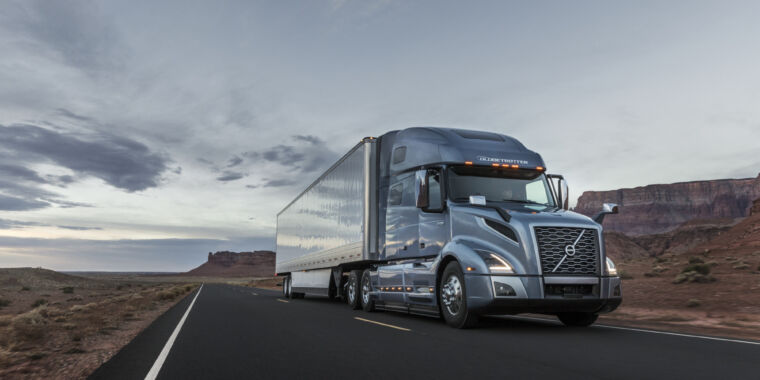Volvo Trucks North America
A recent initiative known as Super Truck II, conducted by the Department of Energy, has been posing challenges to manufacturers of Class 8 heavy trucks, which are responsible for hauling substantial weights of up to 80,000 lbs (36.3 tonnes) of freight. Truck manufacturers, such as Daimler Trucks North America and Volvo Trucks North America, were tasked with developing large trucks that could operate using 50 percent less fuel than trucks present on the roads in 2017, and they have risen to meet this challenge.
While it will take some time for all the efficiency enhancements from the program to be integrated into production trucks, truck manufacturers have already begun implementing some key takeaways into their commercial vehicles. Volvo’s latest VNL model, a Class 8 long-haul truck specifically designed for the North American market, is a prime example of this application.
“It’s replacing the previous generation that had been around for several decades,” stated Keith Brandis, VTNA’s VP of systems and solutions. Unlike its predecessor, which was based on a global cab concept and design, the VNL stands out as a completely new and regionally tailored offering for North America.
Fueling Efficiency Advances
Although the VNL may not achieve the same level of fuel efficiency improvements as the ambitious research project, a fuel economy improvement of 10 percent is still noteworthy. When applied to a heavy-duty truck traveling 125,000 miles a year (201,000 km) at a rate of 8 to 8.8 miles per gallon (27–30 L/100 km), this enhancement can lead to significant benefits for customers, as highlighted by Brandis.
“Truck operators desire efficiency to enhance their productivity, profitability, and sustainability,” explained Chris Stadler, VTNA’s product marketing manager. Improving the bottom line is a key priority for them.
Safety Enhancements
However, the VNL is not merely focused on reducing fuel consumption but also emphasizes safety features. This ensures the continuous operation of the trucks while safeguarding both the asset and its cargo. Moreover, these safety advancements aim to aid fleets in attracting or retaining drivers, a critical requirement especially in the United States where there is currently a shortage of approximately 80,000 truck drivers.
One noteworthy aspect of the VNL, when compared to the previous global cab model, is the absence of speed limitation. European heavy-duty trucks are restricted to a maximum speed of 56 mph (90 km/h), prompting adjustments in the VNL design, as pointed out by Stadler.
To optimize aerodynamics, the truck design has been meticulously crafted to minimize drag. Drawing insights from the Super Truck and Super Truck II programs, features such as cab-side fairings that facilitate airflow continuity between the tractor and trailer have been implemented. This innovation has resulted in an impressive 7 percent increase in overall fuel efficiency.
Image/Photo credit: source url





